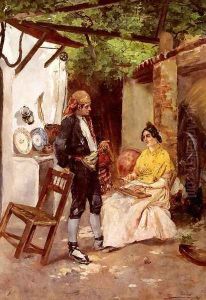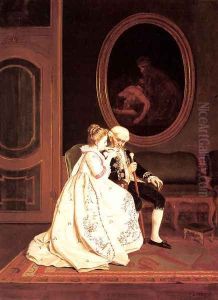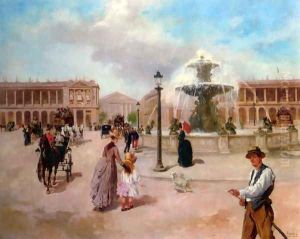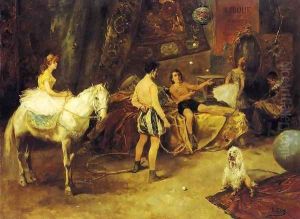Vicente de Parades Paintings
Vicente Palmaroli González was a significant figure in the 19th-century Spanish art scene, born in 1846 in Madrid, Spain. Often mistakenly referred to as Vicente de Parades, Palmaroli was actually the son of an Italian lithographer who settled in Spain. This mix of cultural backgrounds influenced his artistic development from an early age. He initially trained under his father, Gaetano Palmaroli, a notable lithographer, which provided him with a strong foundation in the graphic arts. However, it was his transition to painting that marked the beginning of his significant contributions to Spanish art.
Vicente Palmaroli's education continued at the Real Academia de Bellas Artes de San Fernando, where he was exposed to and inspired by the works of the Spanish masters. His early works were primarily focused on religious and historical themes, typical of the academic art tradition of the time. However, as his style evolved, he became known for his genre paintings, depicting scenes of everyday life with a delicate sensitivity and attention to detail. His ability to capture the nuances of light and shadow, as well as the emotional subtlety of his subjects, garnered him considerable acclaim.
In 1878, Palmaroli was appointed as the director of the Spanish Academy in Rome, a position that allowed him to influence a new generation of Spanish artists. This role also afforded him the opportunity to immerse himself in the rich artistic culture of Italy, which further refined his style and approach to painting. Throughout his career, Palmaroli exhibited his works widely, both in Spain and internationally, earning numerous awards and honors. His paintings are characterized by their elegance, technical skill, and the warmth of their depiction of human subjects.
Palmaroli's impact on Spanish art was not limited to his own works; as a mentor and director at the Spanish Academy in Rome, he played a crucial role in the development of several notable Spanish artists of the late 19th and early 20th centuries. He was a bridge between the traditional and the modern, advocating for an art that was rooted in classical techniques yet open to the innovations of the modern world. Vicente Palmaroli González passed away in 1903, leaving behind a legacy that continues to inspire and influence the world of Spanish art.



